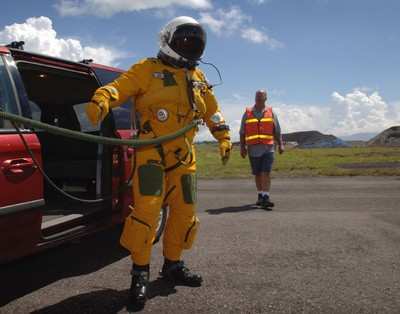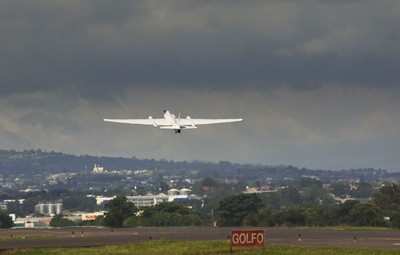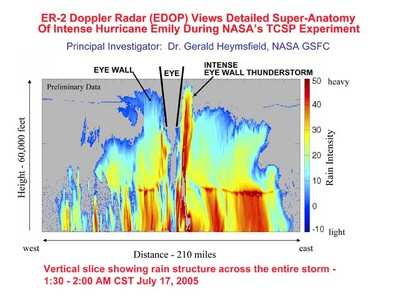Wed, Jul 20, 2005
NASA'S Tropical Cloud Systems And Processes Mission In Costa
Rica
NASA's ER-2 achieved a first July 17 when it flew a series
of data-gathering missions above turbulent Hurricane Emily -- the
most powerful storm the weather plane and its pilot, NASA pilot
David Wright, have ever tackled.

"Hurricane Dennis was much kinder," Wright remarked after his
flight. "Emily just didn't want me around."
Wright is NASA's chief pilot for the Tropical Cloud Systems and
Processes (TCSP) mission in Costa Rica, the month-long research
partnership with the National Oceanic and Atmospheric
Administration (NOAA) to study the birthing conditions for tropical
storms, hurricanes and related phenomena. NASA and NOAA
successfully flew multiple missions July 6 through 9 over Hurricane
Dennis, and since July 16 have been tracking Emily -- a Category 4
hurricane -- using some of the world's most sophisticated
high-flying and ground-based weather research equipment.

The ER-2 plane overflew Hurricane Emily July 17 around 4 a.m.
EDT, heading west-northwest at 17-18 knots. Emily was on track at
that time to reach the Yucatan Peninsula of Mexico Monday evening.
Emily is an extremely powerful storm, rated a borderline Category
4-5 on the Saffir-Simpson scale, which means the storm is producing
sustained maximum wind speeds of approximately 150-155 mph.

The flight was the first in which the ER-2 has collected data in
such an intense tropical system. Flying twice over the eye of the
hurricane at 65,000 feet, the plane encountered pronounced
turbulence -- an unusual occurrence, especially so early in the
hurricane season. The eye-wall clouds powering Emily were extremely
energetic and deep. Large amounts of lightning were detected by
ER-2 instrumentation, as well as thunderclouds that towered to at
least 60,000 feet. NASA instruments recorded unprecedented detail
of the hurricane's vertical structure and precipitation levels.

The TCSP mission is sponsored by NASA's Science Mission
Directorate. TCSP participants include NOAA, five NASA centers, 10
American universities and partner agencies in Costa Rica. For more
information about TCSP, visit:
More News
Aero Linx: JAARS Nearly 1.5 billion people, using more than 5,500 languages, do not have a full Bible in their first language. Many of these people live in the most remote parts of>[...]
'Airplane Bounced Twice On The Grass Runway, Resulting In The Nose Wheel Separating From The Airplane...' Analysis: The pilot reported, “upon touchdown, the plane jumped back>[...]
"Burt is best known to the public for his historic designs of SpaceShipOne, Voyager, and GlobalFlyer, but for EAA members and aviation aficionados, his unique concepts began more t>[...]
"Polaris Dawn, the first of the program’s three human spaceflight missions, is targeted to launch to orbit no earlier than summer 2024. During the five-day mission, the crew >[...]
There Are SO Many Ways To Get YOUR Aero-News! It’s been a while since we have reminded everyone about all the ways we offer your daily dose of aviation news on-the-go...so he>[...]
 ANN's Daily Aero-Linx (05.04.24)
ANN's Daily Aero-Linx (05.04.24) NTSB Final Report: Quest Aircraft Co Inc Kodiak 100
NTSB Final Report: Quest Aircraft Co Inc Kodiak 100 Aero-News: Quote of the Day (05.04.24)
Aero-News: Quote of the Day (05.04.24) Aero-News: Quote of the Day (05.05.24)
Aero-News: Quote of the Day (05.05.24) Read/Watch/Listen... ANN Does It All
Read/Watch/Listen... ANN Does It All






